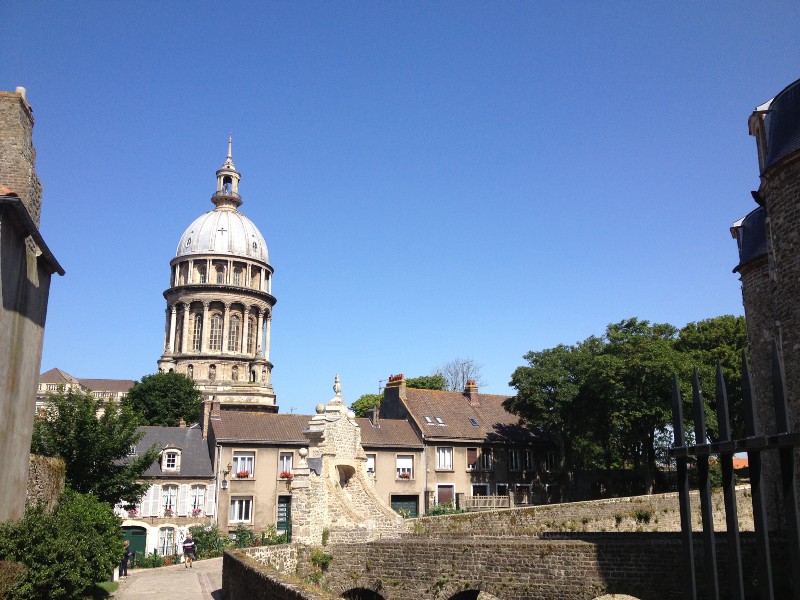Travel Guide: Boulogne sur Mer, France

It was a bright, blue, sunny summer’s morning in London as I boarded the fast train from St Pancras station to Dover. My first ferry journey to France.
P&O Ferries operate a shuttle bus from the train station at Dover to the ferry terminal. You should take this. It was such a nice day that I decided to walk — it was a bit further than I expected but I still made it to the port 30 minutes before departure time. Unfortunately that wasn’t quite early enough — because of security and immigration requirements, passenger boarding is locked down 45 minutes prior to departure. Luckily the helpful staff were able to switch me onto the next ferry departing an hour later, and the Pride of Kent soon had me sailing smoothly across the English Channel, leaving the chalky white cliffs of Dover in our wake.
The seaside village of Boulogne sur Mer is a short drive from Calais — you can follow the coastal road and on a clear day possibly glimpse the English coast across the water.
One of the main attractions of Boulogne sur Mer is Nausicaá — the Centre National de la Mer. Nausicaá is an aquarium and education centre, 13 million visitors have passed through its doors since opening in 1991.
I really like aquariums, but to describe Nausicaá simply as an aquarium isn’t really doing it justice. This is a big operation, with a strong focus on education and sustainability — including a guide to buying fish when dining-out that prioritises local and seasonal fish.
The exhibits are presented in logical groupings — aquatic environments sensitively created, and giving the visitor a unique opportunity to view the ecosystems teeming within our oceans.
My favourite resident was a young loggerhead turtle (born in captivity and soon to be fitted with a tracking beacon and released into the Mediterranean), although I also loved the Sea Dragons from Australia — intricate tiny creatures from a different universe. Sharks, penguins, and sea lions are all crowd-pleasers.
This is a popular destination for English school-children on their first big excursion. It’s an easy day-trip. However I was staying on to explore more of the Boulonnais region.
The next morning I walked down to the port and watched the boats of Boulogne’s fishing fleet returning to the quay. Boulogne is home to France’s largest fishing fleet with 150 boats. The crews seemed happy with their catch, busily throwing back anything too small, or using hammers to dislodge recalcitrant crabs who are too time-consuming to untangle.
The best of the catch is sold direct to restaurants and the public from the quayside market stalls operated by the families of the boat owners — the rest of the catch is handed over to the adjacent processing plant.
Like many traditional industries, family is central to the fabric of the fishing fleet. Boats are named after the children of the boat owner — or religious saints if there are no children — and each new boat is carefully christened before it’s allowed to embark out to sea.
From the port I jumped on a boat tour — the Florelle. I’m not usually a fan of boat tours, but the weather was so good it was easy just to kick back in the sun and enjoy the steady motion of the boat. This region is known as the Opal Coast because when rising or setting the sun creates unique colour effects in the water, making this a favoured destination for painters.
For lunch, I walked into the big industrial estate on the port where the food processing plants are based. Somewhere in the middle is Brasserie Le Chatillon, which had been recommended to me. Unless you had some local knowledge you’d never find this place, but it’s definitely worth tracking down.
The brasserie opens for breakfast and then closes about 3PM. The clientele is a combination of factory workers eating sandwiches and beer at the bar, to local businessmen sitting down to a full lunch. The food is very good (mainly seafood of course), and there’s a great atmosphere.
To walk off our lunch, I tackled the coastal walk from Boulogne to neighbouring Wimereaux. This takes a good hour, but is worth doing.
I took a taxi back to Boulogne and made the most of the last of the day’s sun by working on my tan on the beach.
For my final day in Boulogne sur Mer, I headed to the markets in the square in front of the St Nicolas church. The markets are held each Wednesday and Saturday, also on Sundays on the quayside. With some trepidation, I tried some horse sausage — rich, meaty, and quite tasty. About 3,000 horses are butchered each week in this region to meet consumer demand.
I then walked uphill to the old fortified part of town. This is a fascinating glimpse into the history of this part of the world. The fortifications have been in place in various configurations for the last 2,000 years. Walking around the ramparts gives you sweeping views out to sea as well as inland. You also need to visit the cathedral, with its spectacular dome.
I wandered along Rue de Lille and headed back down the hill to the quayside where I ordered some lunch from one of the popular friterie outlets.
‘Delicious!’ I declared, biting enthusiastically into an enormous baguette filled with fries and a sausage.
‘This is a local specialty…’ advised the food vendor. ‘The sausage is called a Frikandel — it’s made from a bit of everything.’ It was very good.
The Hitchcock-ian seagulls began to circle, so I quickly finished the baguette and jumped in the car for the short journey back to Calais, and I was soon on to the ferry back to England.
Congratulations @g-tv! You received a personal award!
You can view your badges on your Steem Board and compare to others on the Steem Ranking